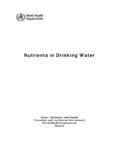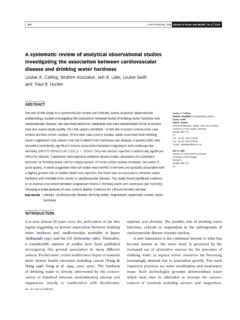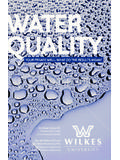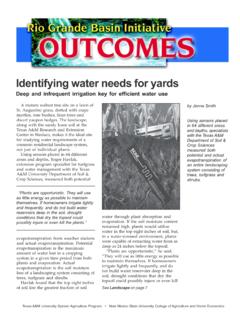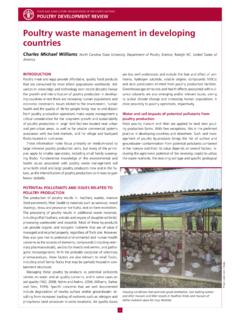Transcription of 4. ESSENTIAL NUTRIENTS IN DRINKING WATER - …
1 414. ESSENTIAL NUTRIENTS IN DRINKING WATER Manuel Olivares, MD Institute of Nutrition and Food Technology University of Chile Santiago, Chile Ricardo Uauy, MD, PhD Institute of Nutrition and Food Technology University of Chile Santiago, Chile London School of Hygiene and Tropical Medicine University of London London, United Kingdom _____ I. INTRODUCTION Most of the inorganic chemicals in DRINKING WATER are naturally occurring. They are acquired by the contact of WATER with rocks and soil and the effects of the geological setting, including climate (1-4). However, the chemical composition of DRINKING WATER also depends on the contaminating effects of industry, human settlements, agricultural activities and WATER treatment and distribution (1-4).
2 Depending on WATER quality at the source, filtration, coagulation, and addition of chemicals to adjust pH and/or control corrosion treatments are employed (1-5). In addition, chlorination or iodination may be used for disinfection and fluoridation for the prevention of dental caries (6-8). Leaching of minerals from metal components used in WATER treatment plants and plumbing materials occurs when pH and hardness of WATER are not adjusted. Some of the main sources of dissolved metals include: for Cu- copper or brass plumbing system; Fe- cast iron, steel, and galvanised plumbing system; Zn- zinc galvanised pipes; Ni- chromium-nickel stainless plumbing system; Pb- derived from tin-lead or lead solder; and for Cd- as an impurity in zinc galvanised pipes or cadmium containing solders (1-4,9).
3 Recently, fortification of DRINKING WATER has been used in the prevention of iron deficiency in children (10) and to provide iodine in select populations (11). II. DEFINITION OF NUTRITIONAL REQUIREMENTS AND RECOMMENDATIONS Experts from many countries and international organisations have defined nutritional needs and recommendations. The requirement of a nutrient , as defined by the World Health Organization, Food and Agriculture Organization of the United Nations and the International Atomic Energy Agency (WHO/FAO/IAEA) Expert Consultation on Trace Elements in Human Nutrition and Health, is the lowest continuing level of nutrient intake that, at a specified efficiency of utilisation, will maintain the defined level of nutriture in the individual (12).
4 Basal requirement is the intake needed to prevent pathologically relevant and clinically detectable signs of impaired function attributable to inadequacy of the nutrient . However, the basal requirement does not account for the needs to maintain nutrient reserves in the body or consider the amount sufficient to ensure that absorption and retention were not operating at maximum capacity. Therefore, the value needed to fulfill the basal requirement plus these additional needs to maintain a level of tissue storage or other reserves constitutes the normative requirement (12). 42 However, how important reserves are is an open question.
5 The criterion utilised to define nutrient inadequacy may differ for individuals at different life stage. On the other hand, the knowledge of the criteria used to define nutrient inadequacy is important to integrate and/or compare requirements obtained from different sources of evidence. Several methods have been utilised to estimate requirements and each has particular strengths and weaknesses. nutrient requirements can be calculated by using metabolic balance studies at different levels of intake, factorial modelling, in which the amount of the nutrient needed to replace utilisation and losses is calculated, depletion/repletion studies, and/or epidemiological evidence (12-17).
6 Balance studies and factorial analysis calculations can be biased since individuals can adapt to the level of nutrient intake by modifying absorption and/or losses. As previously mentioned, micromineral requirements can be studied by experimental diets with different micromineral intakes, thus determining the minimal nutrient intake that prevents the development of biochemical abnormalities or functions. However, these experimental diets may also have modifications in other NUTRIENTS that could affect absorption of the studied nutrient or influence the biochemical or physiological parameters employed in the assessment of its status.
7 In addition, the biochemical parameters may not be sufficiently sensitive and/or specific in detecting marginal nutrient status. Another method is to calculate the requirements based on epidemiological studies of nutrient status carried out in healthy populations with different nutrient intake profiles (12-15,17). Dietary reference intakes are provided to promote optimal health by avoiding consequences of nutrient deficiency and excess. However, for some NUTRIENTS there is limited information to scientifically support the nutritional needs across age ranges, gender and physiological states. The Institute of Medicine of the US National Academy of Sciences (IOM) has developed dietary reference intakes (DRI) that include the Estimated Average Requirement (EAR), Recommended Dietary Allowance (RDA), Adequate Intake (AI) and Tolerable Upper Intake Level (UL) (13).
8 The EAR, RDA, and AI values represent the amount of the nutrient to be supplied by foods from a diet similar to those consumed in Canada and the United States. EAR is the daily intake of a nutrient that is estimated to meet the requirement of 50% of apparently healthy individuals of a given sex and age. The RDA is the average daily intake level that is sufficient to meet the nutrient requirement of of the population of apparently healthy persons of a given sex and age. This value is intended to be used as a goal for daily intake by all individuals to be reached as an average over a given time; usually weeks or months.
9 When there is insufficient information available to calculate an EAR, an AI value based on experimentally derived intake levels or approximations of customary mean nutrient intakes by group or groups of healthy subjects, is used instead of the traditional RDA. The UL is the highest level of daily nutrient intake that is likely to pose no risk of adverse health effect for almost all individuals in a specified sex and age group. The development of a UL for a nutrient requires: 1. Hazard identification (identification of all known adverse effects associated with the nutrient ). 2. Analysis of dose response studies to identify the lowest no observed adverse effect level (NOAEL) based on all identified hazards, and 3.
10 Application of an uncertainty factor, that compensates for extrapolation from the observed to the general population (13,18). WHO/FAO/IAEA has established safe levels of population mean intakes that would suffice to ensure a low prevalence of individuals at risk of either inadequate or excessive intakes (12). The lower limit of the population mean intake is the lowest mean intake at which the population risks of depletion remain acceptable when judged by normative criteria , while the upper limit is the maximum population mean intake at which the risks of toxicity remain tolerable . Between these limits the risk of inadequacy or excess is acceptably low.










